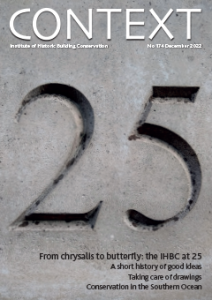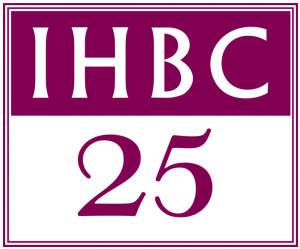 Marking the 25th anniversary of the IHBC – #IHBC 25 – our ‘IHBC at 25’ issue of Context looks back at where today’s multidisciplinary institute came from, how it has evolved and where it might go, and this celebratory NewsBlog features IHBC Chair David McDonald and Mike Brown, IHBC President on the IHBC’s past, present… and future.
Marking the 25th anniversary of the IHBC – #IHBC 25 – our ‘IHBC at 25’ issue of Context looks back at where today’s multidisciplinary institute came from, how it has evolved and where it might go, and this celebratory NewsBlog features IHBC Chair David McDonald and Mike Brown, IHBC President on the IHBC’s past, present… and future.
… [the IHBC] endeavoured to master the tsunami of change that is modern life, all the while staying true to our professional principles and charitable purpose…
David McDonald, and Mike Brown write:
Perhaps unusually for a conservation body, while we celebrate our past, we have always focused on the future and the increasingly important role the historic built environment can play in framing it. To mark this silver anniversary in the IHBC’s own history, this issue of Context highlights some examples of what the institute is doing today and takes a few tentative glimpses into its future.
The institute’s first chair, Mary King, and first president, Malcolm Airs, look back at the emergence of the IHBC in the 1990s and how things have changed. We hear views from the inside, about what draws new members to the IHBC, and from the outside, looking at the institute through the lens of other professional bodies. Perhaps we should be using the popular social media meme: ‘how it started; how it’s going’. It is clearly going pretty well as we discover the determined fighting spirit of the IHBC annual school organisers when emerging from the pandemic, and snapshots from Sandy Halliday and David Burton of the remarkable content of the Aberdeen annual school.
The IHBC has grown and come of age as a genuinely multidisciplinary institute. It developed from the Association of Conservation Officers, which is why the original membership in 1997 was almost entirely made up of conservation officers, with some other local-authority- related members. The members came from different professional backgrounds, certainly, but still had a single professional focus. Today’s IHBC continues to welcome local authority members but it now has a significant majority working in the private sector, bringing a much wider spectrum of backgrounds, disciplines and interests. Whatever their professional backgrounds, IHBC members are united by a shared professional interest in historic build- ings and areas and their conservation. They find their home as conservation professionals in an environment that is welcoming to all, but still maintains the highest standards of competence for its accredited members.
Two important documents from the early days of the institute remain essential to today’s IHBC:
- The IHBC Code of Conduct ensures that members act proficiently, honestly and with integrity, and provide informed independent professional advice.
- The Areas of Competence continue to serve the institute well as the core definition of members’ skill sets, being used throughout all IHBC operations from membership to Context content, and from events to forward planning.
 Among the news, events and projects marking the IHBC’s 25th anniversary through the #IHBC25 celebration programme (see ihbc. org.uk/ihbcat25) is a modernisation review of the descriptors which frame these Areas of Competence. The Areas of Competence, along with the Conservation Professional Practice Principles (which, as Dave Chetwyn writes on page 22, are also being reviewed as part of #IHBC25), form the backbone of IHBC’s professional standards.
Among the news, events and projects marking the IHBC’s 25th anniversary through the #IHBC25 celebration programme (see ihbc. org.uk/ihbcat25) is a modernisation review of the descriptors which frame these Areas of Competence. The Areas of Competence, along with the Conservation Professional Practice Principles (which, as Dave Chetwyn writes on page 22, are also being reviewed as part of #IHBC25), form the backbone of IHBC’s professional standards.
The IHBC has become a mature and increasingly diverse organisation, better able to reflect and shape our times. Membership of the IHBC is now widely respected within government and the heritage sector as the expected mark of the conservation professional. The institute’s work in establishing the All-Party Parliamentary Group on Conservation, Places and People, which David Blackman describes on page 20, marked its inroad into high-profile political advocacy. The APPG’s first report The Value of Heritage is being circulated with this issue of Context.
The IHBC has moved a long way from those early days, but to the members, who value it so much, it remains much more than a professional institute. It is our voice and standing in a changing world.
How it has changed! When the IHBC was launched in St Pancras Chambers on 9 October 1997, the internet was still a novelty and on dial-up, Google had yet to start, and it would be another 10 years before the first iPhone was released. Few saw climate change as a threat and, closer to home, the case for the economic benefits of heritage was only just beginning to be heard. In our 25-year history the IHBC has mapped and endeavoured to master the tsunami of change that is modern life, all the while staying true to our professional principles and charitable purpose. We were, are and will forever be challenged in this way but, knowing this, we can best prepare (through investigating our renewal as a chartered body, for example) for whatever slings and arrows confront us. Our greatest strength is our membership and the many volunteers who keep the IHBC so vital.
See David McDonald and Mike Brown in Context HERE
See the full issue HERE
See more on Context HERE
Reading Context helps IHBC members develop their skills across all of the IHBC’s Areas of Competence, and so is a critical baseline in addressing priorities in Continuing Professional Development (CPD)
Access the online archive
See more IHBC background and guidance on IHBC CPD and on how you might use past, current and future issues of Context
See the formal guidance paper on IHBC CPD (scheduled for update)
See more on the IHBC Competences and Areas of Competence
See more on #IHBC25

